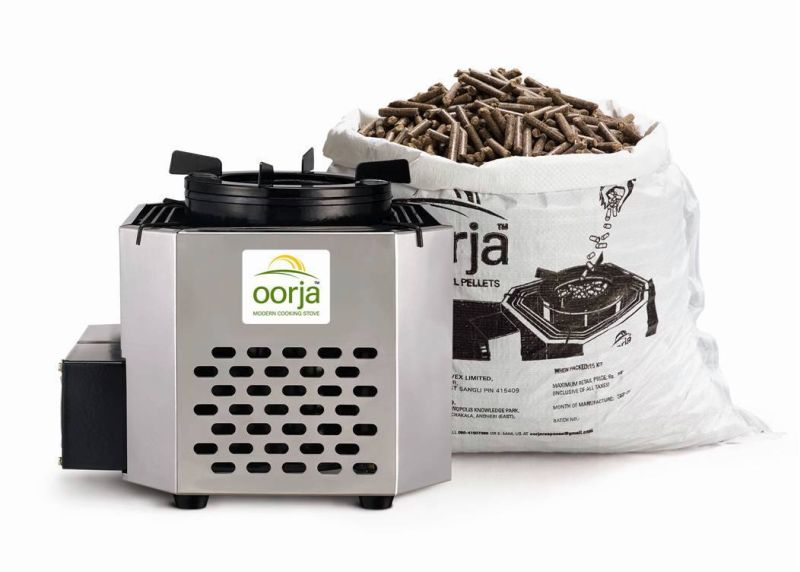We would only be able to control air pollution when we find out all its causes and eliminate them. Countries like China are proving that it isn’t hard to control pollution once you take strict measures. However, other countries like India are still bearing its wrath. Although, when talking about pollution, it is mostly vehicles and factories that come to our mind. Nevertheless, we cannot take them to be the sole contributors. In fact, some scientists are even of the opinion that cows are amongst the main reasons behind global warming. There are still speculations about that, but the role of many other things like stoves is quite certain. In fact, to solve this problem many designers are coming up with eco-friendly stoves.
15 Eco-friendly stoves designed to reduce environmental pollution
From the conventional Chulhas used in villages to the more widely used LPG stoves in the cities, emission of greenhouse gases is one of the greatest of concerns of today. Though LPG stoves are said to be most convenient and cause less pollution, studies have shown that these stoves emit 15 times more CO2 than wood and kerosene.
LPG contains propane, butane, unsaturated propylene, and butylenes liquefied under high pressure. We should keep in mind that even small amount leaks of LPG can be hazardous to the environment. People are increasingly adopting more eco-friendly ways of cooking that reduce environmental pollution, more economical and fuel efficient.
1. Rocket Stove

The “Rocket Stove” is an ecofriendly stove. It is designed by a Japanese health researcher Junji Takano. It is not only easy to use but also easy to make and is cost effective. Junji managed to create this “green” stove using large tin cans riveted to the ground. According to Junji, it has high heat transfer capacity causing less pollution which means less carbon dioxide is released into the atmosphere in comparison with a conventional stove. Apparently, this Rocket stove is 60% less fuel than the other usual stoves. By using just 500 g of cardboard, one can cook 6 cups of rice and 2 kinds of dishes using this stove.
2. Eco Fire Pot stove
“Eco Fire Pot stove” is an environment-friendly stove for a healthy life. Adama Karma is a natural therapist who believes in living close to nature was the one to design this stove. One can make this stove from scrap metals, clay or bricks according to the consumer’s requirements. It looks like a usual LPG stove with two burners with fuel enriched under the burner. Adama claims the fuel to be consisting of waste vegetable oil mixed with methanol or ethanol and wood ash. The stove can burn for six hours. It turns out that this stove does not emit anything which is harmful and is also cost efficient.
3. Score

“Score” is yet another ecofriendly stove which uses 1 kg of fuel per hour (wood or dung) created by the researchers of University of Nottingham. This stove not only produces heat but the heat it also converts its heat to acoustic energy. This in turn is converted to electricity with a linear alternator. This dual purpose stove ensures reduced fuel consumption by three times over traditional stoves and the electrical energy generated can charge 12 V battery, or provide mains AC voltage. Score project has proved to be successful in the rural areas of Kenya, Uganda, and Nepal.
4. Ecofriendly Cooking Stove for Bamburi
Moving mountains trust has introduced an environment friendly stove with back boilers which produces hot water as a by-product of their cooking. The stove which consists of clay has a narrow opening to introduce wood as the fuel and a hob with a unique shape to ensure least heat dissipation. The specially designed stove minimizes fuel consumption, requiring less wood collection and emits very less smoke minimizing bronchial problems. Though this was made specifically for the villagers of Bamburi, it will be a better alternative for traditional Chullas used in other villages.
5. Solar Stove

Solar stoves work by harnessing UV radiation from the sun ad converting it to heat. In a country like India with tropical climate, harnessing solar energy is a smart way to control pollution. Though you cannot cook at night and cloudy whether conditions, by resorting to solar stoves as an alternative to LPG or other conventional cooking stoves in rural as well as urban areas (which would be most of the day time), pollution can be curtailed to a great extent.
6. Eco-Chulha
The “Eco-Chulha” is yet another stove by Abellon Clean Energy with the motive to provide cleaner solution to counter cooking smoke. The Eco-Chulha is a community stove specially designed to facilitate large scale cooking. It uses “Pellexo” which is a carbon-free pellet-fuel. It consists mainly of forest and agricultural residues. The stove is convenient to use, produces very little smoke devoid of carbon and allows faster cooking which reflects its heat efficiency.
7. Oorja Stove
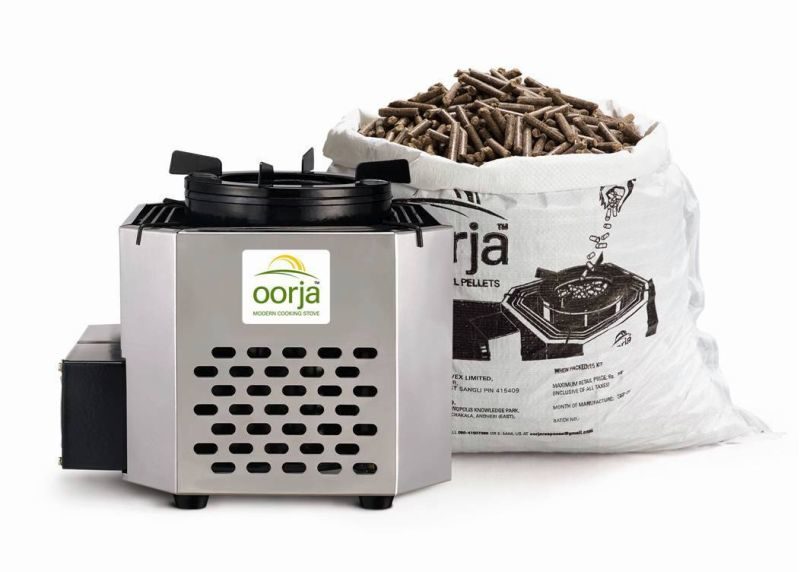 One such environment friendly stove designed by the Indian Institute of Science is the “Oorja stove”. This stove is almost smokeless, more efficient, and cheaper in terms of cost when compared to LPG. We obtain this fuel from agricultural waste like bagasse, groundnut husk, or cotton stalks. These wastes are highly compressed and made into pellets which the Oorja stove burns efficiently using an innovative gasification process. Today, over 4,75,000 homes use the Oorja stove across villages in Maharashtra, Karnataka, Tamil Nadu, and Andhra Pradesh.
One such environment friendly stove designed by the Indian Institute of Science is the “Oorja stove”. This stove is almost smokeless, more efficient, and cheaper in terms of cost when compared to LPG. We obtain this fuel from agricultural waste like bagasse, groundnut husk, or cotton stalks. These wastes are highly compressed and made into pellets which the Oorja stove burns efficiently using an innovative gasification process. Today, over 4,75,000 homes use the Oorja stove across villages in Maharashtra, Karnataka, Tamil Nadu, and Andhra Pradesh.
8. Enviro-fuels Stove
Enviro-fuels stove will soon hit the market, designed by Enviro Fuels Manufacturing Inc. of Florida. Though, it uses coal as the fuel, they claim that the stove’s design allows it to produce maximum heat efficiency and maximum fuel combustion. The company’s president and CEO, Larry Hunt, explained that the fuel produces temperatures as high as or higher than 500 degree Celsius.
9. Kenya Ceramic Jiko
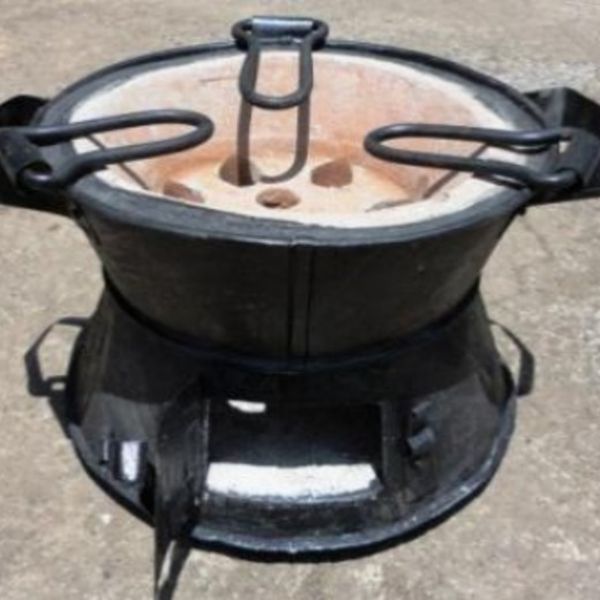 “Kenya Ceramic Jiko” (KCJ), designed by the efforts of some local and international agencies has become a widely used stove in Africa. It has a unique hour-glass shape. This shape is different from a traditional jiko allowing it to utilize maximum heat. Also, it encompasses a ceramic liner which helps in increasing efficiency at least by 1/4th compared to a traditional jiko. Moreover, it also reduces fuel usage by 30-50%.
“Kenya Ceramic Jiko” (KCJ), designed by the efforts of some local and international agencies has become a widely used stove in Africa. It has a unique hour-glass shape. This shape is different from a traditional jiko allowing it to utilize maximum heat. Also, it encompasses a ceramic liner which helps in increasing efficiency at least by 1/4th compared to a traditional jiko. Moreover, it also reduces fuel usage by 30-50%.
10. Electric Cooking Stoves
Electric cooking stoves are a great alternative to LPGs in urban areas considering the fact that it does not produce any smoke. The time taken for cooking is faster using an electric cooker. No carbon-dioxide emission means no pollution. Although it has its own disadvantages of cost of electricity consumption, for those who can afford it, it’s a great alternative ensuring cleaner cooking. Resorting to such eco-friendly stoves and eco-sensitive ways of cooking will make a large difference in the years to come.
11. Cleaner-burning cook stove
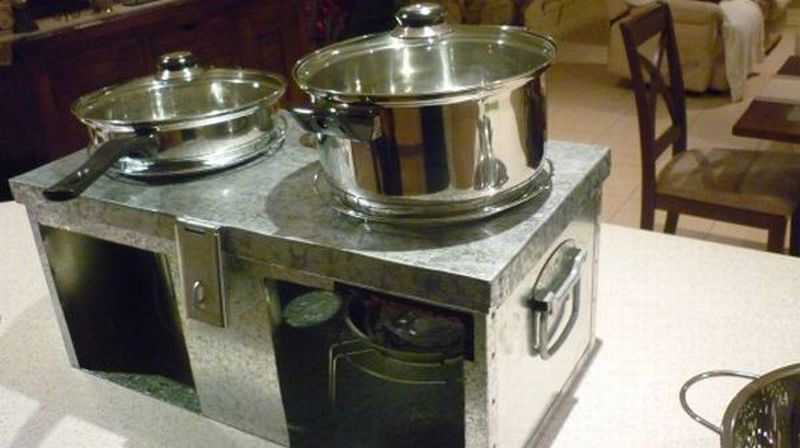 The Eco Fire Pot Stove is an innovation that uses biodiesel, which allows women in developing countries to cook using a comparatively much cleaner cooking gas fuel than the toxic fuel-producing substances like wood, kerosene and coal. The stove is cheaper in price for this is now made of sheet metal but is also possible to make the stove from scrap metal, clay and bricks, which means the cost spent will be more only for the burner.
The Eco Fire Pot Stove is an innovation that uses biodiesel, which allows women in developing countries to cook using a comparatively much cleaner cooking gas fuel than the toxic fuel-producing substances like wood, kerosene and coal. The stove is cheaper in price for this is now made of sheet metal but is also possible to make the stove from scrap metal, clay and bricks, which means the cost spent will be more only for the burner.
Discussing more on the mechanism of how this stove works will help you to understand that this stove is also much more eco friendly and is less harmful reducing the “death sentence” that every women is forced to by spending hours for cooking in front of the traditional cook stoves. The stove is a box with grated burner holes on the top, with each hole having a metal receptacle underneath for holding the wick made from natural fiber, which is being left to be soaked at the end in a pool of clean burning crude biodiesel, “made from waste vegetable oil blended with methanol or ethanol and wood ash.” This stove provides six hours of burning time, allowing you to prepare three meals in a day.
12. Humanitarian Stove Design uses carbon negative dung as fuel
 A startling statistic revealed by World Health Organization shows that more children (under five years of age) die from inefficient cooking fires than any other single cause. And even beyond the safety factor, many largely deforested countries are already facing fuel problems for their cooking stoves. So, in a righteous bid to rectify the adverse situation, engineering students from University of Adelaide have gathered to created a low cost, energy efficient stove infused with user friendly safety features. They have collaborated with local partners from Nepal to manufacture these effectual stoves that will be fueled by bio-degradable and sustainable dung.
A startling statistic revealed by World Health Organization shows that more children (under five years of age) die from inefficient cooking fires than any other single cause. And even beyond the safety factor, many largely deforested countries are already facing fuel problems for their cooking stoves. So, in a righteous bid to rectify the adverse situation, engineering students from University of Adelaide have gathered to created a low cost, energy efficient stove infused with user friendly safety features. They have collaborated with local partners from Nepal to manufacture these effectual stoves that will be fueled by bio-degradable and sustainable dung.
The designer’s main concern was to achieve an optimized combustion factor by utilization of readily available fuel. Now, with the effects of deforestation negating the usage of wood fuel, the engineers thought of using dung as a perfectly carbon negative alternative. Moreover, from the perspective of design, they have used ‘TLUD technology’ (top, lit, up draft technology) for their energy efficient stove prototype. This unique technology has a two-pronged advantage over conventional bottom, lit, up draft mechanisms found in ordinary stoves. Firstly, the system can save up to 75 percent of fuel, and secondly it also allows the utilization of organic wastes products (like grass, twigs and shells) as substitute fuel.
13. Bamako Stove replaces ‘three stone’ open fire in a sustainable fashion
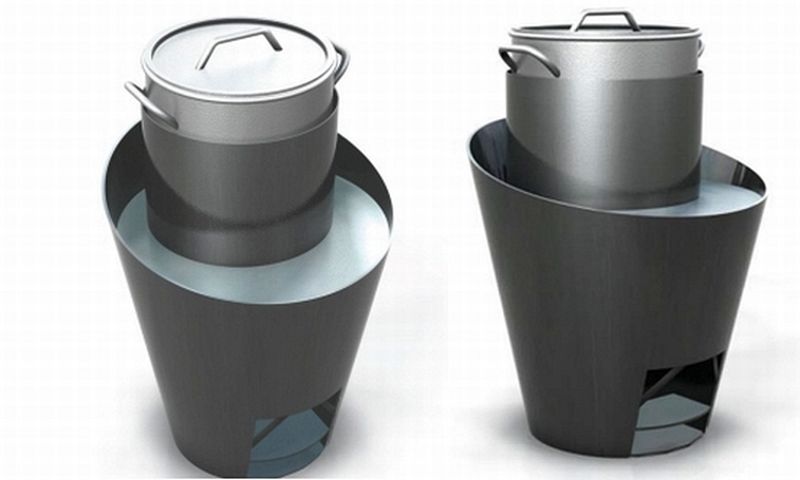 Designed by Douglas Schaller, Ara Acle and Jill Holm, the Bamako Stove is an inexpensive stove to be crafted in Mali from local materials by traditional blacksmiths. The stove is designed as an efficient alternative to the currently used “three stone” open fire as the stove reduces wood consumption. It is made from scrap steel with a protective outer housing, an insulating skirt and an aluminum heat exchange ring. Wood is fed through a front chute, which is easily removed for cleaning. Nested imported cooking pots serve to steam millet, the region’s staple food.
Designed by Douglas Schaller, Ara Acle and Jill Holm, the Bamako Stove is an inexpensive stove to be crafted in Mali from local materials by traditional blacksmiths. The stove is designed as an efficient alternative to the currently used “three stone” open fire as the stove reduces wood consumption. It is made from scrap steel with a protective outer housing, an insulating skirt and an aluminum heat exchange ring. Wood is fed through a front chute, which is easily removed for cleaning. Nested imported cooking pots serve to steam millet, the region’s staple food.
Implementing the Bamako stove could create a domino effect in which multiple problems would be addressed and many would benefit. Income generated by selling produce from the gardens could repay microloans and buy farming aids such as plows and oxen to replace hand-working the fields with only a rudimentary hoe. Blacksmiths in Bamako could receive increased business. Local residents trained as traveling salespeople (approximately 6 persons) could gain new employment. Malian rural families could gain vitamins from the vegetables produced by the gardens and have better health (including fewer lung ailments from inhaled smoke). Villages experience less soil erosion and more productive cropland. The overall result could affect entire villages and result in major land resource conservation.
14. SCORE stove charges your gadgets while you cook
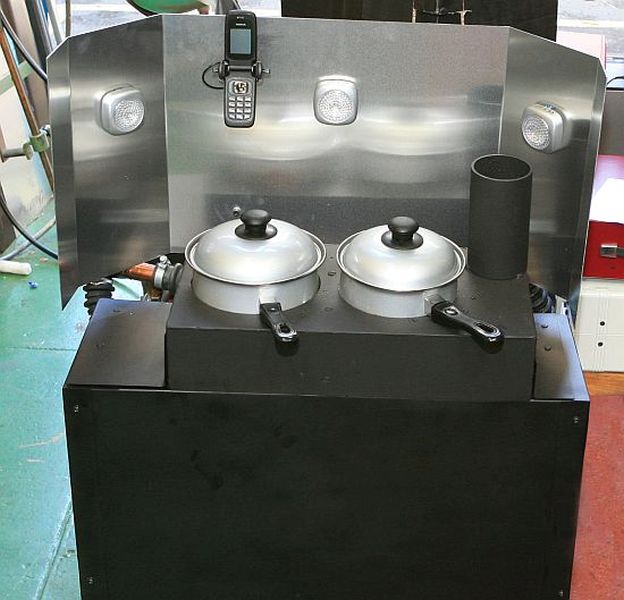 Systems that generate renewable energy are in high demand, especially in the underdeveloped nations of the world where people are in need of systems that perform more than one task. In places such as Nepal a vast majority of the population relies on wood for cooking, which not only is showing its mark on the forest reserves but also on the health of the people.
Systems that generate renewable energy are in high demand, especially in the underdeveloped nations of the world where people are in need of systems that perform more than one task. In places such as Nepal a vast majority of the population relies on wood for cooking, which not only is showing its mark on the forest reserves but also on the health of the people.
Researchers over at the University of Nottingham have developed a low-cost stove that doubles as a renewable electricity generator, which can answer the problems faced by millions in the world.
The stove, known as SCORE or Stove for Cooking, Refrigeration and Electricity, converts the heat generated by burning wood, dung or any other locally-available biomass, into acoustic energy which is then converted into electricity through a linear generator.
15. Piet smoke-free indoor stove burns ethanol instead of wood
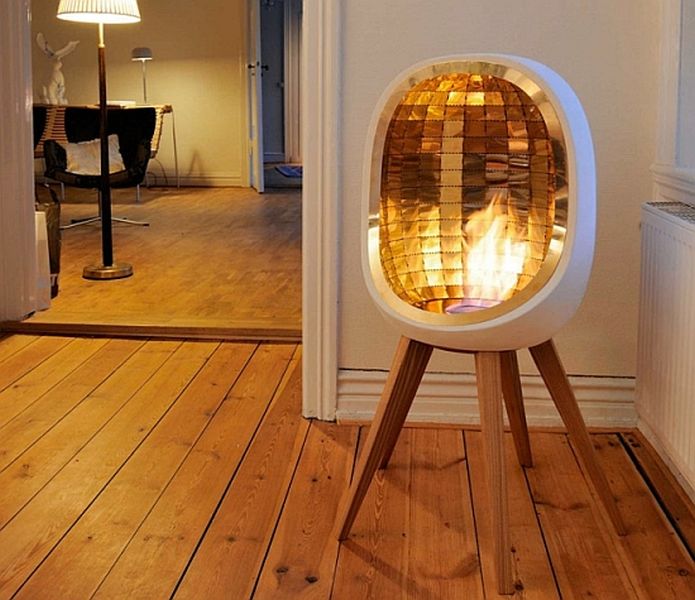 Winter is just around the corner and time is right for you to think of some green ways to heat your home when the outside temperature plunges. Piet by industrial designer Fredrik Hyltén-Cavallius is a stove that can be placed indoors without the risk of burning your expensive furniture and the best part is that it produces no smoke as it runs on ethanol.
Winter is just around the corner and time is right for you to think of some green ways to heat your home when the outside temperature plunges. Piet by industrial designer Fredrik Hyltén-Cavallius is a stove that can be placed indoors without the risk of burning your expensive furniture and the best part is that it produces no smoke as it runs on ethanol.
Since the stove doesn’t produce any smoke or soot, it eliminates the need of a chimney. Piet comes with a brass reflector that evenly distributes heat to different parts of the room. A layer of rock wool fire insulation between the reflector and the outer ceramic shell keeps Piet’s body cool, which allows users to place the stove in any room they like.


